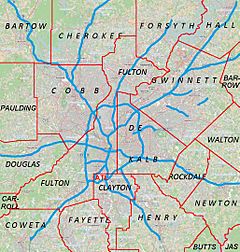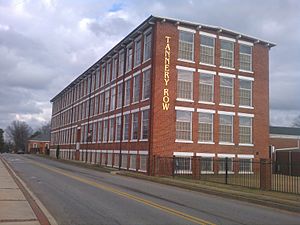Buford, Georgia facts for kids
Quick facts for kids
Buford, Georgia
|
|
|---|---|
|
City
|
|
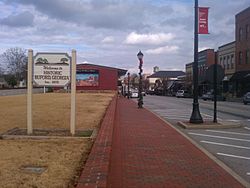
Main Street
|
|
| Country | United States |
| State | Georgia |
| Counties | Gwinnett, Hall |
| Area | |
| • Total | 18.22 sq mi (47.18 km2) |
| • Land | 18.13 sq mi (46.96 km2) |
| • Water | 0.09 sq mi (0.22 km2) |
| Elevation | 1,053 ft (321 m) |
| Population
(2020)
|
|
| • Total | 17,144 |
| • Density | 945.46/sq mi (365.05/km2) |
| Time zone | UTC-5 (Eastern (EST)) |
| • Summer (DST) | UTC-4 (EDT) |
| ZIP codes |
30515, 30518, 30519
|
| Area code(s) | 770, 678 |
| FIPS code | 13-11784 |
| GNIS feature ID | 2403950 |
Buford is a city in the state of Georgia, USA. It is located in both Gwinnett and Hall counties. In 2020, about 17,144 people lived there.
Most of Buford is in Gwinnett County. This area is part of the larger Atlanta-Sandy Springs-Marietta Metropolitan Statistical Area. A small part of the city is in Hall County.
Buford started in 1872 when a railroad was built. This railroad connected Charlotte, North Carolina, to Atlanta. The city was named after Algernon Sidney Buford. He was the president of the Atlanta and Richmond Air-Line Railway at that time.
The city became famous for its leather industry. This industry, led by the Bona Allen Company, helped Buford grow. Being a railway stop also helped the population increase. This growth continued until after the Great Depression.
Today, Buford has its own school district, the Buford City School District. Many famous musicians and athletes have lived here. You can also find fun places like museums, community centers, and the Mall of Georgia. The Mall of Georgia is the biggest mall in the state. Lake Lanier Islands are also nearby.
Contents
History of Buford
Buford first appeared in history books in the early 1800s. The land where Buford now stands was once part of Cherokee territory. Even after a treaty in 1817 gave the land to the United States, many Cherokee people still lived there until the 1830s.
The first non-Native American settlers arrived in the late 1820s or early 1830s. However, many more people moved to the Buford area in the 1860s.
After the American Civil War, a railroad was built. This was part of the Richmond and Danville Railroad System. In 1865, two railroad owners, Thomas Garner and Larkin Smith, bought land near the railway. They started to build the city of Buford.
The city was named after Algernon Sidney Buford. He was the president of the Atlanta and Richmond Air-Line Railway. The town grew quickly after the railway was finished in 1871. Buford became an official town on August 24, 1872. It was renamed the City of Buford in 1896.
The Leather City: Bona Allen Company
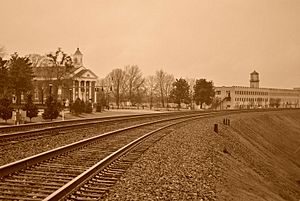
In the late 1800s and early 1900s, Buford became famous for making leather. It was even called "The Leather City." Buford made many leather items. These included saddles, horse collars, bridles, and shoes.
The leather industry began with R.H. Allen. He opened a harness shop and tannery in 1868. This was before the railway was even finished. R.H. Allen's brother, Bona Allen, moved to Buford in 1872. He started the Bona Allen Company the next year.
The leather business quickly became the city's biggest industry. It faced challenges like fires. A fire in 1903 destroyed several businesses. Another fire in 1906 almost destroyed the horse collar factory.
Bona Allen saddles were sold through the Sears mail order catalog. Many Hollywood actors used saddles made by the Bona Allen Company. These included cowboy actors like Gene Autry and Roy Rogers. Roy Rogers even used a Bona Allen saddle on his horse, Trigger.
You can see a statue of Roy Rogers and a saddle-maker in downtown Buford. It shows them saddling Trigger. The Bona Allen Company did well during the Great Depression in the 1930s. Farmers chose horses over expensive tractors, which increased the need for leather products.
The Bona Allen Company built Tannery Row in downtown Buford. It was a shoe factory built in 1919. The shoe factory closed in 1942 after a short worker strike. It reopened briefly during World War II to make shoes for the military. Then, it closed again in 1945.
In 2003, Tannery Row became the Tannery Row Artist Colony. It now has art galleries and studios for artists.
After the Great Depression, people used fewer horses for farming. Tractors became more common. The Bona Allen Company slowly got smaller. The tannery was sold to the Tandy Corporation in 1968. Buford's leather industry ended after a fire at the tannery in 1981. The Tandy Corporation decided not to rebuild it.
Buford's Geography and Climate
| Weather chart for Buford, Georgia | |||||||||||||||||||||||||||||||||||||||||||||||
|---|---|---|---|---|---|---|---|---|---|---|---|---|---|---|---|---|---|---|---|---|---|---|---|---|---|---|---|---|---|---|---|---|---|---|---|---|---|---|---|---|---|---|---|---|---|---|---|
| J | F | M | A | M | J | J | A | S | O | N | D | ||||||||||||||||||||||||||||||||||||
|
5.2
50
32
|
5.3
54
34
|
5.2
63
41
|
3.7
71
48
|
3.8
77
56
|
4.1
84
65
|
4.2
87
69
|
4.4
86
68
|
4.6
80
61
|
3.9
71
51
|
4.3
62
42
|
4.7
52
34
|
||||||||||||||||||||||||||||||||||||
| temperatures in °F precipitation totals in inches |
|||||||||||||||||||||||||||||||||||||||||||||||
|
Metric conversion
|
|||||||||||||||||||||||||||||||||||||||||||||||
Buford is in northern Gwinnett County, Georgia. A small part of the city extends north into Hall County. It is a suburb of the Atlanta metropolitan area.
In 2010, the city had a total land area of about 17.07 square miles (44.26 km²). Most of this is land, with a small amount of water. Buford is about 1,183 feet (361 meters) above sea level.
Buford gets its water from Lake Lanier. This lake is formed by a dam on the Chattahoochee River.
Weather in Buford
Buford has a humid subtropical climate. This means it has four seasons. Summers are hot and humid, and winters are cool.
July is usually the warmest month. The average high temperature is around 87°F (31°C). January is the coldest month, with an average high of about 50°F (10°C). The highest temperature ever recorded was 107°F (42°C) in 1952. The lowest was -8°F (-22°C) in 1985.
Buford gets rain throughout the year. February usually has the most rain, about 5.3 inches (13.5 cm). April is typically the driest month, with about 3.7 inches (9.4 cm) of rain.
People of Buford
| Historical population | |||
|---|---|---|---|
| Census | Pop. | %± | |
| 1880 | 896 | — | |
| 1890 | 496 | −44.6% | |
| 1900 | 1,352 | 172.6% | |
| 1910 | 1,683 | 24.5% | |
| 1920 | 2,500 | 48.5% | |
| 1930 | 3,357 | 34.3% | |
| 1940 | 4,191 | 24.8% | |
| 1950 | 3,812 | −9.0% | |
| 1960 | 4,168 | 9.3% | |
| 1970 | 4,640 | 11.3% | |
| 1980 | 6,578 | 41.8% | |
| 1990 | 8,771 | 33.3% | |
| 2000 | 10,668 | 21.6% | |
| 2010 | 12,225 | 14.6% | |
| 2020 | 17,144 | 40.2% | |
| U.S. Decennial Census | |||
| Race | Num. | Perc. |
|---|---|---|
| White (non-Hispanic) | 8,431 | 49.18% |
| Black or African American (non-Hispanic) | 2,301 | 13.42% |
| Native American | 24 | 0.14% |
| Asian | 1,012 | 5.9% |
| Pacific Islander | 13 | 0.08% |
| Other/Mixed | 716 | 4.18% |
| Hispanic or Latino | 4,647 | 27.11% |
In 2020, there were 17,144 people living in Buford. There were 5,003 households and 3,607 families in the city.
Buford's Economy
Buford, like the rest of Gwinnett County, has a sales tax of 6%. This includes a 4% state tax and a 2% local tax. In 2008, CNN Money said Buford was one of the "100 best places to live and start a business."
In the past, Buford's economy was based on its railway stop and leather industry. But as demand for leather dropped and other ways to travel became popular, these industries changed. By the 1980s, they were no longer a main part of Buford's economy.
Today, about 65% of Buford's population aged 16 or older are working or looking for work. About 59% of these people have jobs. The power tool company Makita has a factory in Buford with 400 employees.
Parks and Fun in Buford
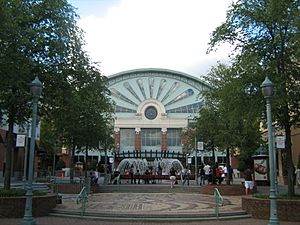
Buford has many walking trails. Over 7 miles (11 km) of trails can be reached from the Gwinnett Environmental & Heritage Center and the Mall of Georgia. This includes part of the Ivy Creek Greenway.
You can also find walking trails at Bogan and Buford Dam parks. Bogan Park has baseball fields, playgrounds, and a community center with a swimming area. Buford Dam Park is next to Lake Lanier. It has places for swimming and other fun activities.
Besides the county parks, Buford has five city parks. A new community center was finished in early 2012.
The southern part of Lake Sidney Lanier and the Lake Lanier Islands are also in Buford.
The Mall of Georgia is the largest mall in Georgia. It has over 200 stores and a 20-screen Regal Cinema with IMAX. Even though it's just outside Buford's official city limits, it uses Buford as its mailing address.
Education in Buford
The city of Buford has its own school district called the Buford City School District. This district serves students who live within the city limits. Students living outside the city limits attend schools run by Gwinnett County Public Schools or Hall County Public Schools.
The Buford City School District has three elementary schools: Buford Academy, Buford Senior Academy, and Buford Elementary. It also has Buford Middle School and Buford High School.
The Buford-Sugar Hill Branch of the Gwinnett County Public Library is located in Buford.
Arts and Culture in Buford
The Gwinnett Environmental & Heritage Center is a museum and cultural center in Buford. It opened in August 2006. The center teaches kids about water and the environment. It also shares information about Gwinnett's history, including the Cherokee and Creek cultures.
The Chesser-Williams House is a historic home from before the 1850s. It was moved to the museum to become part of its cultural exhibits.
The Buford Community Center is a large building that opened in 2012. It is across from Buford City Hall. The center has a museum, a theater with 290 seats, and an outdoor amphitheater. It also has rooms for meetings, parties, and weddings.
Media and Movies
Buford is part of the Metro Atlanta area. Its main TV stations are WXIA-TV (NBC), WANF (CBS), WSB-TV (ABC), and WAGA-TV (Fox). WGTV is the local station for Georgia Public Television (PBS).
The Gwinnett Daily Post is the most popular newspaper in Buford. The Atlanta Journal-Constitution and Gainesville Times are also available.
Several movies have been filmed in and around Buford. These include Killers (2010), Need for Speed, Blended, and A Simple Twist of Fate.
Getting Around Buford
Transportation
Two major highways pass through Buford: Interstate 85 and Interstate 985. They both run northeast to southwest through the city. Buford is Exit 115 on I-85 and Exit 4 on I-985. Georgia State Route 20 also goes through Buford.
The Gwinnett County Transit offers public transportation in Buford and Gwinnett County. There is also a Park and Ride in Buford that connects to Atlanta.
The closest airport is the Gwinnett County Airport in Lawrenceville. It is about 14 miles (23 km) from Buford. The closest major airports are Hartsfield–Jackson Atlanta International Airport, about 48 miles (77 km) away, and Athens Ben Epps Airport, about 53 miles (85 km) away.
Famous People from Buford
Buford has been home to many famous people, especially athletes and musicians.
Several players from the Atlanta Falcons football team have lived in Buford. These include defensive tackle Corey Peters and cornerback Chris Owens. Former Falcons players Jeff Merrow and Scott Case also live here.
Other athletes who live in Buford include retired hockey player Randy Manery, professional drag racing driver Kurt Johnson, and professional baseball pitcher Jon Huber. Professional baseball player Jerry McQuaig died in 2001. Roy Carlyle, a Major League Baseball outfielder in the 1920s, was born in Buford.
Many professional athletes have graduated from Buford High School. These include wide receiver P. K. Sam and his brother quarterback Lorne Sam. Professional WNBA player Christi Thomas also graduated from there. Brownie Wise, who helped make Tupperware very successful, was born in Buford.
Several musicians live in Buford. These include Widespread Panic guitarist Jimmy Herring and De'Angelo Holmes from the hip-hop group Ying Yang Twins. Grammy Award-winning songwriter Joe South lived in Buford before he passed away in 2012.
See also
 In Spanish: Buford (Georgia) para niños
In Spanish: Buford (Georgia) para niños


